A.M. Leonard ART17 Double Cut Pruner: Product Review
We independently evaluate all recommended products and services. If you click on links we provide, we may receive compensation.
A quality pruner for super clean cuts up to ¾ inch.
Available on Amazon
Buy ItA.M. Leonard has been around since 1885 but even though it is an industry leader in the horticultural field, many homeowners aren’t familiar with the brand. With the ART17 double cut pruner, A.M. Leonard introduces a style of pruner that’s most likely unfamiliar to the typical American gardener, though it has been used in Europe for many years. It’s neither a bypass pruner nor an anvil pruner. Instead, it’s a cross between the two, with two sharpened blades that come together as the final cut is made.
CUTTING BLADES MAKE CLEAN CUTS
The blades are made from 5/8” hot-forged high-carbon Swedish steel, giving them a very sharp and long lasting edge.
The greatest advantage of two sharpened steel blades that come together is that they make very clean cuts without crushing the wood. As a result, cuts heal faster and cause less stress on the plant and, consequently, less risk of disease.
The cutting precision of the A.M. Leonard ART17 was excellent and left no rips, tears, or crushing of the wood. With the fine tips, I was able to make perfect cuts at the intersection between the branch and the limb, known as the “branch bark collar”.
Another benefit of the double cut design is that it makes similarly clean cuts regardless of which hand you hold it in (lefties rejoice!) and which direction you make your cuts from.
CUTTING PERFORMANCE IS DIFFERENT FROM BYPASS PRUNERS
The cuts made by the A.M. Leonard ART17 are significantly different from the typical bypass pruner; I noticed a distinct ridge in the center of the branch being cut. But, unlike some bypass pruners, there was no pinching of the outside bark by the counter blade (some bypass pruners can leave an indent on the outside of a branch’s bark, which can slow the healing process).
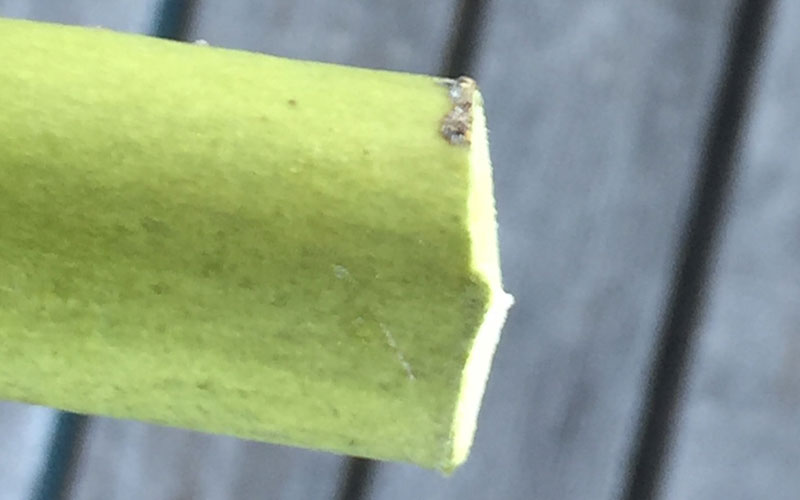
The pruners make a staggered cut across branches and limbs, but the cut is very clean
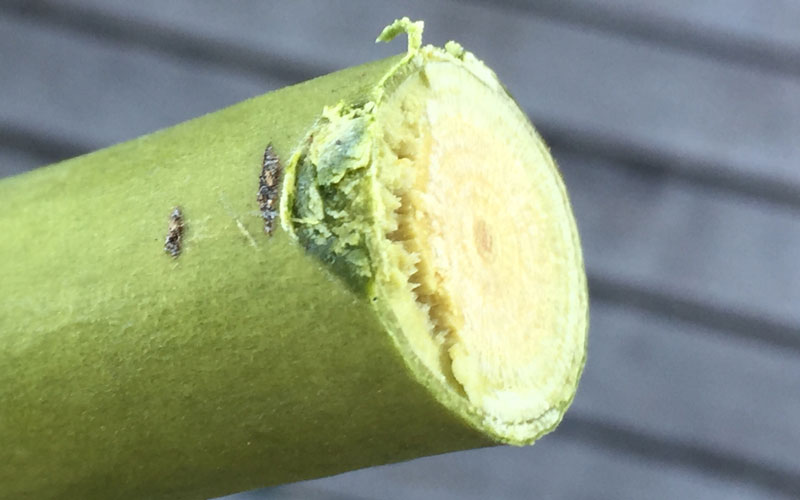
Cutting with some bypass pruners can leave less than a clean cut.
Not Suitable For Cutting Soft Material
The double cut pruner design originated in the orchard industry, where it is preferred for it’s extremely clean cuts. These cuts don’t damage bark or crush cut stems, and it is an excellent design for cutting through woody material.
The pruner does not work as well on softer stems, such as when deadheading or cutting back herbaceous perennials. So this pruner isn’t one that would be used for all your pruning or cutting tasks in the garden.
CUTTING HEAD HAS LOTS OF MICRO-ADJUSTMENT
The cutting head is much the same as a bypass pruner, with a central bolt to secure both blades. The A.M. Leonard ART17 Double Cut Pruner has a micro adjustment screw and hinge mechanism that makes sure the center bolt will not move while cutting and helps with micro-adjusting the blade tension for the perfect cut. There’s also a micro-adjustment screw that protrudes from the handle that sets the proper spacing of the cutting blades.
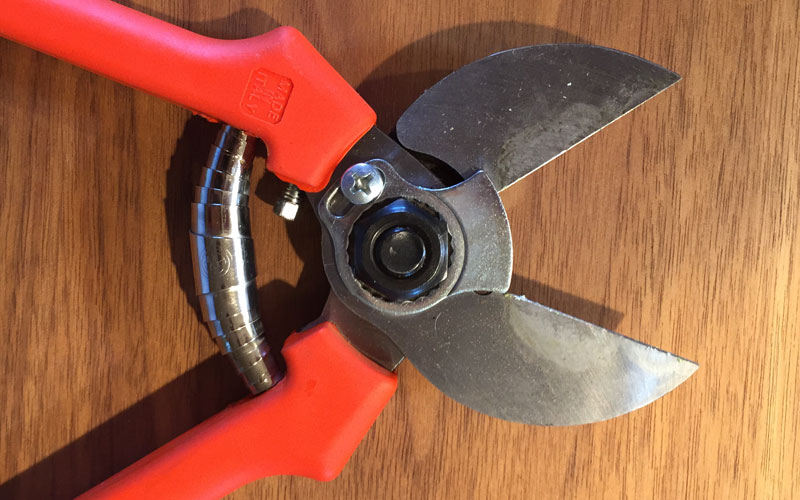
Multiple fine tuning adjustments allow for clean cuts.
COMFORTABLE HANDLES AND SECURE LOCKING MECHANISM
The handles are extremely comfortable. They are made with a composite material and incorporate two ridges near the head of the pruner that make for a perfect hand position.
The pruner locking mechanism is a spring loaded swing bar at the end of the handles that holds the handles securely in the locked position. When the pruner is open, the bar can be swung and locked under the handle (parallel to the handle) or left sticking straight out the back of the handle. Don’t leave the locking bar pointing toward the other handle or you’ll end up hitting it with every cut.
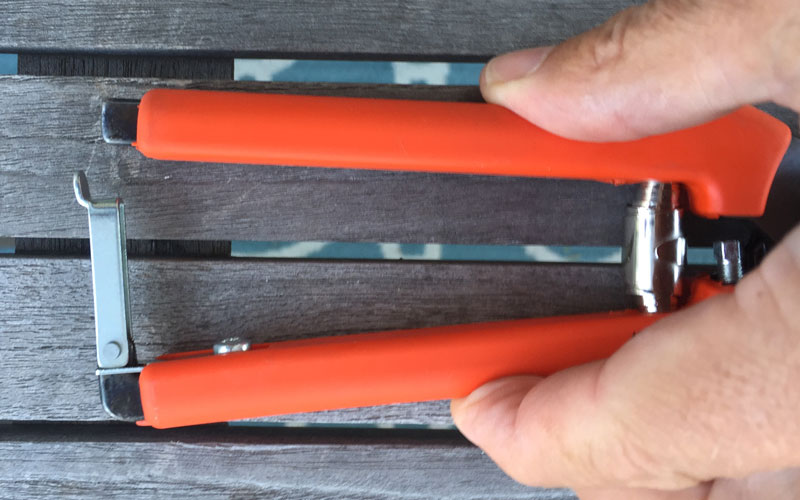
The bar lock holds the handles securely but may get in the way if not tucked away while pruning
DIFFICULTY IN CUTTING 1” THICK MATERIAL
A.M. Leonard claims that the ART17 Double Cut Pruner can slice through 1 inch material, but I was able to cut only part way through 1 inch medium soft live wood. There may be softer woods like canes, stalks and soft vines that the pruner could manage a 1 inch cut. The largest cut I was able to make in a medium soft live wood was ¾ inch. This cut was clean, just like all the other smaller diameter cuts I made.
NO REPLACEMENT BLADES
The head is an integrated one-piece design so there are no replacement blades available. And, as with all cutting tools, the blades will eventually need sharpening. Just looking at the tolerances of the blade closure (they have to fit perfectly together to make a clean cut), I think I’d be hard pressed to sharpen this pruner without causing a deformity in the blade, thereby causing a ragged cut. If you do want to try sharpening the blades, be extremely careful. I’d use a fine grit diamond hone and gently stroke each blade (being sure to maintain the edge angle) an equal number of times.
WARRANTY
A.M. Leonard offers a 30-day complete satisfaction guarantee. Other than that, it only warranties its products to be free from material or workmanship defects.
RECOMMENDATION
This is a very different type of pruner from what you may be used to. I was most impressed with the fine cuts that it made with no damage to the bark. This is a quality pruner that does not skimp on materials and workmanship. The few very minor drawbacks are a handle locking mechanism that could get in the way of the two handles closing, the fact that it only cuts through ¾ inch wood (rather than the 1 inch diameter claimed) and that it’s intended for woody stems only. All things considered I would definitely add a pair of these pruners to my gardening bag.
WHERE TO BUY
The A.M. Leonard ART17 Double Cut Pruner is available directly from A.M. Leonard for $49.99 + 12.99 (standard ground shipping). It’s also available from Amazon for $49.99 + $7.28 (shipping).
Now over to you – Have you tried double cut pruners? Do you see why they are so popular in Europe? Share your thoughts in the comments below!
Enjoyed This Review?
If you liked this review, please sign up for our email updates with reviews, how-to articles and gardening videos!



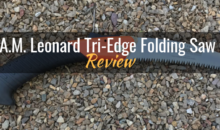



I’d like your opinion about using this double cut pruner for making grafting cuts. I’m thinking of using it for whip grafting and also for cleft grafting, for making 1-1.5″ long diagonal cuts that are much smoother and cleaner than I can accomplish with a good grafting knife (most of my cuts scoop out a bit). I’ve been using a Ronan Multi-cut cutter for whip grafting, but it’s an anvil type so there is some crushing. http://www.ronantools.com/multi-cut-xp-2/
In your review you mention the staggered cut (with a ridge) that this double cut pruner produces, and that has me wondering if that ridge would show up in a long diagonal cut.
What do you think?
John Clemens
Topanga, Ca 90290
The ridge does show up when making long diagonal cuts (I just tested it to be sure) so I don’t think this would be a good choice for making grafting cuts.
Thanks for checking it again…I wonder if the ridge comes from an alignment problem? I’ll definitely hold off on this cutter unless I can find someone who’s solved the ridge problem.
John
I think it’s really just the nature of the design. Because the two blades don’t pass by each other, there’ll always a ridge in the middle where the blades meet at the end of the cut. The tool makes a nice clean cut otherwise.
I’m waiting for a manufacturer of pruners to come up with a good lock design that does not get in the way while using them.
Us too – that’s often a problem! I’m currently working with a nice pair of Dramm snippers with a well-placed lock, and the Felco and ARS hand pruner locks are pretty good in terms of staying out of the way (I especially like the squeeze to release feature on ARS pruners!).